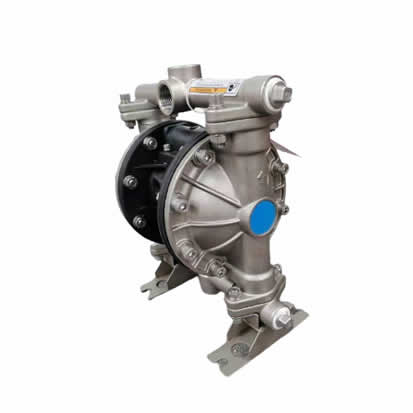The inner system of diaphragm pump and the inner diaphragm installation method are introduced:
Diaphragm pump, also known as control pump, is the main type of actuator, by accepting the control signal output by the modulation unit. Diaphragm pumps use power operation to change fluid flow. Diaphragm pump is widely used in North China, diaphragm pump has four kinds of materials: plastic, aluminum alloy, cast iron, stainless steel. Electric diaphragm pump has four materials: plastic, aluminum alloy, cast iron, stainless steel. Diaphragm pump according to different liquid media are made of nitrile rubber, neoprene rubber, fluorine rubber, polyvinylidene fluoride, polytetrafluoroethylene. To satisfy the need. Placed in a variety of special occasions, used to pump a variety of conventional pump can not be pumped medium.
1. Diaphragm pump equipment system:
Diaphragm pump equipment system is composed of one or more double side pumps, such as a pneumatic double diaphragm pump. The collection tubes on the pump are separated so that each side of the pump pumps out one of the components of the multi-component material, and an accumulator is connected to the output on both sides so that the out-of-phase output of the pump becomes in-phase. Diaphragm isolation valves can be selected to exit on each side of the pump to prevent backflow of mixed materials. If a mixing ratio other than 1:1 is needed, more than one of these pumps can be used together to achieve a variety of mixing ratios. Diaphragm failure monitoring system to detect diaphragm leaks in diaphragm pumps.
The system includes a pump that has a studio containing a working fluid; A pumping chamber for pumping materials into and out of the pump; And a diaphragm to isolate the studio from the pumping room. An optical fiber is connected to the studio to transmit an optical signal through the working fluid. A second fiber is connected to the studio to receive optical signals from the fiber.
An electrical signal building device that creates an electrical signal as it exits the fiber and passes through the uncontaminated working fluid to a second fiber. This electrical signal building device creates a second electrical signal as the optical signal from the fiber passes through the contaminated working fluid to the second fiber. When a second electrical signal is established, leakage of contaminated material through the diaphragm into the studio can be detected.
2, diaphragm pump diaphragm installation method:
It does not affect the volume change requirements of the pump, and make full use of the diaphragm excellent compression performance, in the geometry of the diaphragm, it does not need to increase what costs and workload, and greatly improve the service life of the diaphragm, to ensure the normalization of production and improve the quality of product production, it can be applied to a variety of diaphragm pump diaphragm installation.
Pneumatic diaphragm pump is a new type of conveying machinery, using compressed air as power source, for all kinds of corrosive liquid, liquid with particles, high viscosity, volatile, flammable, highly toxic liquid, can be pumped out, has been formed production, product quality is highly praised. The main characteristics of this pump is not need irrigation water, can pump flowing liquid, and transport some is easy to flow medium, suction range, adjustable head (0-50 meters) air source pressure is only greater than 1kg/cm2 can work, fireproof and explosion-proof, with submersible pump, self-priming pump, impurity pump, shield pump, mud pump all functions and transport machinery many characteristics.
The flow of diaphragm pump is adjusted by rotating regulating mechanism to change the piston stroke. The principle is: rotate the adjusting mechanism of the hand wheel (you can see the position change on the dial), through the adjustable shaft and sliding shaft axial transformation, this movement through the sliding shaft chute into the radial displacement of the eccentric wheel, through the connecting rod to push the piston, due to the change of piston stroke, so as to achieve the purpose of flow regulation.
